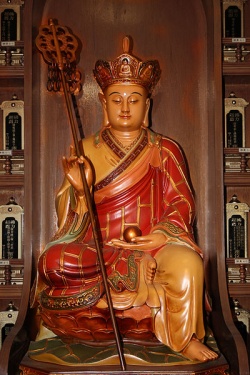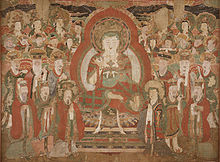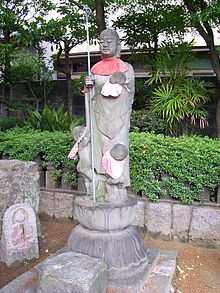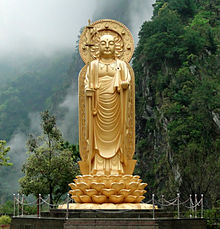Ksitigarbha
- See also :
- See also :
Ksitigarbha (Di Zang Pu-sa): Guardian of the Earth or Earth Store or Earth Treasury King Great Vow Bodhisattva. Great bodhisattva who vowed to not become a buddha until everyone was released from hell. His birthday is observed on the thirtieth day of the seventh lunar month. At that time a Dharma Assembly is held with the chanting of the Sutra of Ksitigarbha Bodhisattva's Fundamental Vows, making of offerings, and performing the ritual of transmigration for the deceased.
See also; the Vajrasamadhi Sutra.
Ksitigarbha (Sanskrit: क्षितिगर्भ Kṣitigarbha) is a Bodhisattva primarily revered in East Asian Buddhism, usually depicted as a Buddhist monk in the Orient. The name may be translated as "Earth Treasury", "Earth Store", "Earth Matrix", or "Earth Womb". Ksitigarbha is known for his vow to take responsibility for the instruction of all beings in the six worlds between the Death of Gautama (Sakyamuni) Buddha and the rise of Maitreya Buddha, as well as his vow not to achieve Buddhahood until all hells are emptied. He is therefore often regarded as the Bodhisattva of Hell beings, as well as the guardian of children and patron deity of deceased children and aborted foetuses in Japanese culture. Usually depicted as a Monk with a Halo around his shaved head, he carries a staff to force open the gates of Hell and a wish-fulfilling jewel to Light up the darkness.
Overview
Ksitigarbha is one of the four principal Bodhisattvas in East Asian Mahayana Buddhism. The others are Samantabhadra, Manjusri, and Avalokitesvara.
At the pre-Tang Dynasty grottos in Dunhuang and Longmen, he is depicted in a classical Bodhisattva Form. After the Tang Dynasty, he became increasingly depicted as a Monk, carrying rosaries and a staff.
His full name in the Chinese script is Dayuan Dizang Pusa (simplified Chinese: 大願地藏菩萨; traditional Chinese: 大願地藏菩薩; pinyin: Dàyuàn Dìzàng Púsà), or the Bodhisattva King Dizang of the Great Vow, pronounced as Dayuan Dizang Pusa in Mandarin, Daigan Jizō Bosatsu in Japanese, and Jijang Bosal in Korean.
This is a reference to his pledge, as recorded in the Sutras, to take responsibility for the instruction of all beings in the six worlds, in the era between the Death of Gautama Buddha and the rise of Maitreya Buddha. Because of this important role, shrines to Ksitigarbha often occupy a central role in any Oriental Mahayana temple, especially within the memorial halls or mausoleums.
Source
As a Brahmin maiden
The story of Ksitigarbha was first described in the Sutra of The Great Vows of Ksitigarbha Bodhisattva, one of the most popular Mahayana Buddhist Sutras. This Sutra is said to have been spoken by The Buddha towards the end of his Life to the beings of the Trayastrimsa Heaven as a mark of Gratitude and remembrance for his beloved mother, Māyādevī. But most scholars believe the Sutra was compiled in China. It stated that Ksitigarbha practised filial piety as a mortal, which eventually led to making great vows to save all Sentient beings.
In the Ksitigarbha Sutra, The Buddha states that in the distant past eons, Ksitigarbha was a Brahmin maiden by the name of Sacred Girl. She was deeply troubled when her mother died, because she had often been slanderous towards the Triple Gem. To save her from the great tortures of Hell, the girl sold whatever she had and used the money to buy offerings that she offered daily to The Buddha of her time, known as The Buddha of the Flower of Meditation and Enlightenment. She prayed fervently that her mother be spared the pains of Hell and appealed to The Buddha for help.
While she was pleading for help at the temple, she heard The Buddha telling her to go home, sit down, and recite his name if she wanted to know where her mother was. She did as she was told and her Consciousness was transported to a Hell realm, where she met a guardian who informed her that through her fervent prayers and pious offerings, her mother had accumulated much Merit and had already ascended to Heaven. Sacred Girl was greatly relieved and would have been extremely happy, but the sight of the Suffering she had seen in Hell touched her Heart. She vowed to do her best to relieve beings of their Suffering in her future lives of Kalpas.
As a Buddhist monk
There is a legend about how Ksitigarbha manifested himself in China, and chose his Bodhimanda to be Mount Jiuhua, one of the Four Sacred Mountains of China in Buddhism.
In the Eastern Han Dynasty, during the reign of Emperor Ming, Buddhism started to flourish, reaching its peak in the era of the Tang Dynasty, eventually spreading to Korea. At the time, Monks and scholars arrived from those countries to seek the Dharma in China. One of these pilgrims was a former prince from Silla named Kim Gyo-gak, who became a Monk under the name of Earth Store (Also called Jijang, the Korean pronunciation of Dizang). He went to Mount Jiuhua in present-day Anhui province. After ascending, he decided to build a hut in a deep mountain area so that he may be able to cultivate.
According to records, Jijang was bitten by a poisonous snake, but did not move, thus letting the snake go. A woman happened to pass by and gave the Monk medicines to cure him of the venom, as well as a spring on her son's behalf. For a few years, Jijang continued to meditate in his hut, until one day, a scholar named Chu-Ke led a group of friends and family to visit the mountain. Noticing the Monk meditating in the hut, they went and took a look at his condition. They had noticed that his bowl did not contain any Food, and that his Hair had grown back.
Taking pity on the Monk, Chu-Ke decided to build a temple as an Offering to him. The whole group descended the mountain immediately to discuss plans to build the temple. Mount Jiuhua was also property of a wealthy person called Elder Wen-Ke, who obliged to build a temple on his mountain. Therefore, Wen-Ke and the group ascended the mountain once more and asked Jijang how much land he needed.
Jijang replied that he needed a piece of land that could be covered fully by his kasaya. Initially believing that a piece of sash could not provide enough land to build a temple, they were surprised when Jijang threw the kasaya in the air, and the robe expanded in size, covering the entire mountain. Elder Wen-Ke had then decided to renounce the entire mountain to Jijang, and became his protector. Sometime later, Wen-Ke's son also left secular Life to become a Monk.
Jijang lived in Mount Jiuhua for 75 years before passing away at the age of 99. Three years after his Nirvana, his tomb was opened, only to reveal that the Body had not decayed. Because Jijang led his wayplace with much difficulty, most people had the intuition to believe that he was indeed an incarnation of Ksitigarbha.
Jijang's well-preserved, dehydrated Body may still be viewed today at the Monastery he built on Mount Jiuhua.
Iconography
Traditional iconography
In Buddhist iconography, Ksitigarbha is typically depicted with a shaven head, dressed in a Monk's simple robes (unlike most other Bodhisattvas, who are dressed like Indian royalty). In his left hand, Ksitigarbha holds a wish-fulfilling jewel; in his right hand, he holds a staff (called shakujo 錫杖 in Japanese), which is used to alert insects and small Animals of his approach, so that he will not accidentally harm them. This staff is traditionally carried by Buddhist Monks. In the Chinese tradition, Ksitigarbha is sometimes depicted wearing a crown like the one worn by Vairocana Buddha. His image is similar to that of the fictional character Tang Sanzang in the classical novel Journey to the West, so observers sometimes mistake Ksitigarbha for the latter.
Like other Bodhisattvas, Ksitigarbha usually is seen standing on a Lotus base, symbolising his release from the karmic Wheel of Rebirth. Ksitigarbha's face and head are also idealised, featuring the third Eye, elongated ears and the other standard attributes of an Enlightened being.
Iconography in Japan
The Narihira Santosen Temple in Katsushika, Tokyo, contains the "Bound Jizō" of Ōoka Tadasuke Fame, dating from the Edo Period. When petitions are requested before Jizō, the petitioner ties a rope about the statue. When the wish is granted, the petitioner unties the rope. At the new year, the ropes of the ungranted wishes are cut by the temple priest. The vandalism of a Jizō statue is the central theme of the Japanese horror film Shibuya Kaidan. The anime series Hell Girl]] is also loosely based on the legend of Jizō and the zanpakuto of Mayuri Kurotsuchi from the manga series Bleach is Konjiki Ashisogi Jizo (Golden Leg-cutting Jizō). The dark mass spell utilised by Jellal Fernandes in the manga series Fairy Tail features the outline of Ksitigarbha's face when launched.
Ksitigarbha as Lord of the Six Ways
[[File:Kṣitigarbha as Lord of the Six Ways (Stein Painting 19).jpg|thumb|left|Painting of Dizang bodhisattva as Lord of the Six Ways from Mogao Grottoes in Dunhuang)] Another category of iconographic depiction is Dizang Bodhisattva as Lord of the Six Ways, an allegorical representation of the Six Paths of Rebirth of the Desire realm (Rebirth into Hell, or as pretas, Animals, Asuras, men, and devas). The Six Paths are often depicted as six rays or beams radiating from the Bodhisattva and accompanied by figurative representations of the Six Paths. Many of these depictions in China can be found in Shaanxi province, perhaps a result of Sanjie Jiao worship in the area. A Japanese variation of this depiction is the Six Jizo, six full sculptural manifestations of the Bodhisattva. An example of this can be found in Konjikidō, the ‘Hall of Gold,’ in the Chūson-ji temple.
In Buddhist traditions
In China
Mount Jiuhua in Anhui is regarded as Ksitigarbha's Bodhimaṇḍa. It is one of the Four Sacred Buddhist Mountains in China)], and at one time housed more than 300 temples. Today, 95 of these are open to the public. The mountain is a popular destination for pilgrims Offering dedications to Ksitigarbha.
In some areas, the admixture of traditional religions has led to Ksitigarbha being also regarded as a Taoist deity, albeit his duties differ to what Ksitigarbha does. For example, in Hong Kong and among overseas Chinese communities, his images are usually found in the memorial halls of Buddhist and Taoist temples.
In Japan
n Japan, Ksitigarbha, known as Jizō, or Ojizō-sama as he is respectfully known, is one of the most loved of all Japanese divinities. His statues are a common sight, especially by roadsides and in graveyards. Traditionally, he is seen as the guardian of children, and in particular, children who died before their parents. Since the 1980s, he has been worshipped as the guardian of the souls of mizuko, the souls of stillborn, miscarried or aborted foetuses, in the Ritual of mizuko kuyō (水子供養, lit. Offering to water children). In Japanese mythology, it is said that the souls of children who die before their parents are unable to cross the mythical Sanzu River on their way to the afterlife because they have not had the chance to accumulate enough good deeds and because they have made the parents suffer. It is believed that Jizō saves these souls from having to pile stones eternally on the bank of the river as penance, by hiding them from demons in his robe, and letting them hear mantras.
Jizō statues are sometimes accompanied by a little pile of stones and pebbles, put there by people in the hope that it would shorten the time children have to suffer in the underworld. (The act is derived from the tradition of building Stupas as an act of Merit-making.) The statues can sometimes be seen wearing tiny children's clothing or bibs, or with toys, put there by grieving parents to help their lost ones and hoping that Jizō would specially protect them. Sometimes the offerings are put there by parents to thank Jizō for saving their children from a serious illness. Jizō's features are commonly made more baby-like to resemble the children he protects.
As he is seen as the saviour of souls who have to suffer in the underworld, his statues are common in cemeteries. He is also believed to be one of the Protective deities of travellers, the dōsojin, and roadside statues of Jizō are a common sight in Japan. Firefighters are also believed to be under the protection of Jizō.
In Southeast Asia
In Theravada Buddhism, the story of a Buddhist monk called Phra Malai, who has the similar qualities of Ksitigarbha, is well known throughout Southeast Asia, especially in Thailand and Laos. Legend has it that he was an Arhat from Sri Lanka, who achieved great supernatural powers through his own Merit and Meditation. He is also honoured as a successor to Maudgalyayana, The Buddha's Disciple foremost for his supernatural attainments. In the story, this pious and compassionate Monk descends to Hell to give teachings & comfort the Suffering Hell-beings there. He also learns how the Hell-beings are punished according to their sins in the different hells.
Mantra
- See also: Ksitigarbha mantra
In Shingon and other schools of East Asian Esoteric Buddhism, the Mantra of Ksitigarbha comes from the "Treasury of Mantras" section of the Mahā Vairocana Sūtra. The effect of this Mantra is producing the "Samadhi Realm of Adamantine Indestructible Conduct." This Mantra is the following:
- In Chinese:
- wēng, hā hā hā, wēnsān módì suōhā (嗡,哈哈哈,温三摩地梭哈 / 嗡,哈哈哈,溫三摩地梭哈)
Other mantras
- In Chinese, this Mantra is called miè dìngyè zhēnyán (灭定业真言 / 滅定業真言). It reads:
- In Chinese Buddhism, the following Mantra is associated with Kṣitigarbha:
- In Korean Buddhism, the following Mantra is associated with Kṣitigarbha:
- In Tibet, the following Mantra is associated with Kṣitigarbha:
- on kaka kabi sanmaei sowaka
Haiku & Senryū
falling freely
tears and rain
on the garden Jizo (anonym)
被鼻涕虫轻轻吻过唇间的石头菩萨
Namekuji-ni
kuchi-o suwareta
ishi-Jizo
The stone image of Jizo
kissed on the mouth
by a slug
(part of a Senryū)
雀の子地蔵の袖にかくれけり
Suzume no ko
Jizoo no sode ni
kakurekeri
The young sparrows
return into Jizo's sleeve
for sanctuary
(haiku by Issa 1814)
.なでしこや地蔵菩薩の跡先に
Nadeshiko ya
jizô bosatsu no
ato saki ni
Blooming pinks
behind and in front
of Saint Jizo
(haiku by Issa)
Aki-no kure
tsuji-no Jizo-ni
abura sasu
In autumn dusk
at the wayside shrine for the Jizo image
I pour more votive oil
(haiku by Buson)
In works of Lafcadio Hearn
The Legend of the Humming of the Sai-no-Kawara, by Lafcadio Hearn:
But lo! the teacher Jizô appears,
All gently he comes, and says to the weeping infants:
"Be not afraid, dears! be never fearful!
Poor little souls, your lives were brief indeed!
Too soon you were forced to make the weary journey to the Meido,
The long journey to the region of the dead!
Trust to me! I am your father and mother in the Meido,
Father of all children in the region of the dead."
And he folds the skirt of his shining robe about them;
So graciously takes he pity on the infants.
To those who cannot walk he stretches forth his strong shakujô,
And he pets the little ones, caresses them, takes them to his loving bosom.
So graciously he takes pity on the infants.
Namo Jizo Bosatsu!
See also:Earth Repository





